A Method of Integrating Air Conditioning Usage Models to Building Simulations for Predicting Residential Cooling Energy Consumption
Abstract
1. Introduction
1.1. Background
1.2. Literature Review
1.3. Aims of This Research
2. Methods
2.1. Data Collection and Pre-Processing
2.2. Occupant Modeling Method
2.2.1. Standard AC Usage Model
2.2.2. Statistical AC Usage Modeling Method
2.2.3. Stochastic Cluster Modeling Method
2.3. Energy Simulation Modeling
3. Results
3.1. Statistical AC Usage Behaviors
3.1.1. AC Usage Characteristics with Outdoor Temperature
3.1.2. AC Setpoint Distribution
3.1.3. AC Operation Duration
3.1.4. Logistic Regression for AC On/Off Behavior
3.2. Stochastic Clustering Modeling
3.2.1. Cluster Analysis Results
3.2.2. AC Operation Schedule Generating
3.3. AC Energy Consumption Simulation
3.3.1. Model Calibration
3.3.2. Comparison of AC Energy Consumption with Different AC Usage Models
4. Discussion
5. Conclusions
- (1)
- The exponential fitting model of AC operating duration and the logistic regression model of the AC opening rate under different indoor and outdoor temperatures were established. Three AC usage modes were developed through cluster analysis;
- (2)
- The Monte Carlo random sampling method was employed in generating AC usage plan and integrated into the EnergyPlus tool in simulation, better predicting the randomness of occupants’ AC usage pattern;
- (3)
- The AC energy consumption based on the fixed AC usage settings from ASHRAE and Chinese standards were about 6.35 times and 2.87 times higher than the measured values, while the values based on statistic behavior model and stochastic cluster model were 1.20 times and 1.83 times of the monitored values, indicating a better performance to reflect the occupants’ AC usage patterns in residential buildings.
Author Contributions
Funding
Data Availability Statement
Conflicts of Interest
Nomenclature
| Mathematical Notations | |
| T | Temperature, °C |
| RH | Relative humidity, % |
| α, β1, β2 | Regression coefficients |
| P | Probability |
| X | Hourly AC energy consumption per day |
| Xnor | Normalized AC usage intensity |
| Xmax, Xmin | Maximum and minimum hourly AC energy consumption values during one day |
| CvRMSE | Root mean square error change coefficient, % |
| NMBE | Standard root mean square error, % |
| Mi | Measured data |
| Si | Predicted data |
| N | Number of data |
| R2 | Coefficient of determination |
| Greek letters | |
| μ | Mean AC setpoint (°C) |
| σ | Data standard deviation (°C) |
| Abbreviation | |
| AC | Air conditioning |
| HSCW | Hot summer and cold winter zone |
| HVAC | Heating, ventilation, and air conditioning |
| PTHP | Packaged terminal heat pump |
| ROC | Receiver operating characteristic |
| DBI | Davies–Bouldin index |
| ASHRAE | American Society of Heating, Refrigerating, and Air Conditioning Engineers |
| AUC | Area under curve, % |
References
- Nejat, P.; Jomehzadeh, F.; Taheri, M.M.; Gohari, M.; Majid, M.Z.A. A global review of energy consumption, CO2 emissions and policy in the residential sector (with an overview of the top ten CO2 emitting countries). Renew. Sustain. Energy Rev. 2015, 43, 843–862. [Google Scholar] [CrossRef]
- China Building Energy Conservation Association. China building energy consumption research report. Architecture 2019, 2, 26–31. [Google Scholar]
- Li, X.; Yao, R. A machine-learning-based approach to predict residential annual space heating and cooling loads considering occupant behaviour. Energy 2020, 212, 118676. [Google Scholar] [CrossRef]
- Day, J.K.; McIlvennie, C.; Brackley, C.; Tarantini, M.; Piselli, C.; Hahn, J.; O’Brien, W.; Rajus, V.S.; De Simone, M.; Kjærgaard, M.B.; et al. A review of select human-building interfaces and their relationship to human behavior, energy use and occupant comfort. Build. Environ. 2020, 178, 106920. [Google Scholar] [CrossRef]
- Hu, S.; Yan, D.; Guo, S.; Cui, Y.; Dong, B. A survey on energy consumption and energy usage behavior of households and residential building in urban China. Energy Build. 2017, 148, 366–378. [Google Scholar] [CrossRef]
- Du, J.; Pan, W.; Yu, C. In-situ monitoring of occupant behavior in residential buildings—A timely review. Energy Build. 2020, 212, 109811. [Google Scholar] [CrossRef]
- González-Torres, M.; Pérez-Lombard, L.; Coronel, J.F.; Maestre, I.R.; Yan, D. A review on buildings energy information: Trends, end-uses, fuels and drivers. Energy Rep. 2022, 8, 626–637. [Google Scholar] [CrossRef]
- Wei, Y.; Zhang, X.; Shi, Y.; Xia, L.; Pan, S.; Wu, J.; Han, M.; Zhao, X. A review of data-driven approaches for prediction and classification of building energy consumption. Renew. Sustain. Energy Rev. 2018, 82, 1027–1047. [Google Scholar] [CrossRef]
- Ahmed, O.; Sezer, N.; Ouf, M.; Wang, L.L.; Hassan, I.G. State-of-the-art review of occupant behavior modeling and implementation in building performance simulation. Renew. Sustain. Energy Rev. 2023, 185, 113558. [Google Scholar] [CrossRef]
- Yan, D.; Hong, T.; Dong, B.; Mahdavi, A.; D’Oca, S.; Gaetani, I.; Feng, X. IEA EBC Annex 66: Definition and simulation of occupant behavior in buildings. Energy Build. 2017, 156, 258–270. [Google Scholar] [CrossRef]
- Ding, Y.; Han, S.; Tian, Z.; Yao, J.; Chen, W.; Zhang, Q. Review on occupancy detection and prediction in building simulation. In Building Simulation; Springer: Berlin/Heidelberg, Germany, 2022; pp. 1–24. [Google Scholar]
- Zou, P.X.; Xu, X.; Sanjayan, J.; Wang, J. Review of 10 years research on building energy performance gap: Life-cycle and stakeholder perspectives. Energy Build. 2018, 178, 165–181. [Google Scholar] [CrossRef]
- Yu, C.; Du, J.; Pan, W. Improving accuracy in building energy simulation via evaluating occupant behaviors: A case study in Hong Kong. Energy Build. 2019, 202, 109373. [Google Scholar] [CrossRef]
- Dadi, M.; Jani, D.D. TRNSYS simulation of an evacuated tube solar collector and parabolic trough solar collector for hot climate of Ahmedabad. In Proceedings of the 3rd International Conference on “Advances in Power Generation from Renewable Energy Sources” 2019, Banswara, India, 11–12 February 2019. [Google Scholar] [CrossRef]
- Zhong, Y.; Knefaty, A.D.; Chen, G.; Yao, J.; Zheng, R. Forecast of air-conditioning duration in office buildings in summer using machine learning and Bayesian theories. J. Build. Eng. 2022, 61, 105218. [Google Scholar] [CrossRef]
- Cuerda, E.; Guerra-Santin, O.; Sendra, J.J.; Neila González, F.J. Comparing the impact of presence patterns on energy demand in residential buildings using measured data and simulation models. In Building Simulation; Springer: Berlin/Heidelberg, Germany, 2019; pp. 985–998. [Google Scholar]
- Yun, G.Y.; Steemers, K. Behavioural, physical and socio-economic factors in household cooling energy consumption. Appl. Energy 2011, 88, 2191–2200. [Google Scholar] [CrossRef]
- Widén, J.; Wäckelgård, E. A high-resolution stochastic model of domestic activity patterns and electricity demand. Appl. Energy 2010, 87, 1880–1892. [Google Scholar] [CrossRef]
- Jia, X.; Pan, Y.; Zhu, M.; Zhu, H.; Li, Z.; Zhang, J.; Zhou, X.; Pan, S.; Wang, C.; Yan, D.; et al. Occupant behavior modules development for coupled simulation in DeST 3.0. Energy Build. 2023, 297, 113437. [Google Scholar] [CrossRef]
- Wu, Y.; Zhou, X.; Qian, M.; Jin, Y.; Sun, H.; Yan, D. Novel approach to typical air-conditioning behavior pattern extraction based on large-scale VRF system online monitoring data. J. Build. Eng. 2023, 69, 106243. [Google Scholar] [CrossRef]
- Zhang, Y.; Bai, X.; Mills, F.P.; Pezzey, J.C. Rethinking the role of occupant behavior in building energy performance: A review. Energy Build. 2018, 172, 279–294. [Google Scholar] [CrossRef]
- Yan, L.; Li, J.; Liu, M.; Hu, M.; Xu, Z.; Xue, K. Heating behavior using household air-conditioners during the COVID-19 lockdown in Wuhan: An exploratory and comparative study. Build. Environ. 2021, 195, 107731. [Google Scholar] [CrossRef]
- Ren, X.; Yan, D.; Wang, C. Air-conditioning usage conditional probability model for residential buildings. Build. Environ. 2014, 81, 172–182. [Google Scholar] [CrossRef]
- Yao, J. Modelling and simulating occupant behaviour on air conditioning in residential buildings. Energy Build. 2018, 175, 1–10. [Google Scholar] [CrossRef]
- Liu, H.; Sun, H.; Mo, H.; Liu, J. Analysis and modeling of air conditioner usage behavior in residential buildings using monitoring data during hot and humid season. Energy Build. 2021, 250, 111297. [Google Scholar] [CrossRef]
- Zaki, S.A.; Hagishima, A.; Fukami, R.; Fadhilah, N. Development of a model for generating air-conditioner operation schedules in Malaysia. Build. Environ. 2017, 122, 354–362. [Google Scholar] [CrossRef]
- Uddin, M.N.; Wei, H.-H.; Chi, H.L.; Ni, M. Influence of occupant behavior for building energy conservation: A systematic review study of diverse modeling and simulation approach. Buildings 2021, 11, 41. [Google Scholar] [CrossRef]
- Balvedi, B.F.; Ghisi, E.; Lamberts, R. A review of occupant behaviour in residential buildings. Energy Build. 2018, 174, 495–505. [Google Scholar] [CrossRef]
- McLoughlin, F.; Duffy, A.; Conlon, M. A clustering approach to domestic electricity load profile characterisation using smart metering data. Appl. Energy 2015, 141, 190–199. [Google Scholar] [CrossRef]
- Pan, S.; Wang, X.; Wei, Y.; Zhang, X.; Gal, C.; Ren, G.; Yan, D.; Shi, Y.; Wu, J.; Xia, L.; et al. Cluster analysis for occupant-behavior based electricity load patterns in buildings: A case study in Shanghai residences. In Building Simulation; Springer: Berlin/Heidelberg, Germany, 2017; pp. 889–898. [Google Scholar]
- Xia, D.; Lou, S.; Huang, Y.; Zhao, Y.; Li, D.H.; Zhou, X. A study on occupant behaviour related to air-conditioning usage in residential buildings. Energy Build. 2019, 203, 109446. [Google Scholar] [CrossRef]
- An, J.; Yan, D.; Hong, T. Clustering and statistical analyses of air-conditioning intensity and use patterns in residential buildings. Energy Build. 2018, 174, 214–227. [Google Scholar] [CrossRef]
- Chen, X.; Li, Z.; Dai, L.; Zeng, W.; Liu, M. Occupant Heating Patterns of Low-Temperature Air-to-Air Heat Pumps in Rural Areas during Different Heating Periods. Buildings 2023, 13, 679. [Google Scholar] [CrossRef]
- Zhang, Y.; Zhang, B.; Hou, J. Simulation Study on Student Residential Energy Use Behaviors: A Case Study of University Dormitories in Sichuan, China. Buildings 2024, 14, 1484. [Google Scholar] [CrossRef]
- Yan, L.; Liu, M. Predicting household air conditioners’ on/off state considering occupants’ preference diversity: A study in Chongqing, China. Energy Build. 2021, 253, 111516. [Google Scholar] [CrossRef]
- Hong, T.; Yan, D.; D’Oca, S.; Chen, C.-F. Ten questions concerning occupant behavior in buildings: The big picture. Build. Environ. 2017, 114, 518–530. [Google Scholar] [CrossRef]
- Jia, M.; Srinivasan, R.; Ries, R.J.; Bharathy, G.; Weyer, N. Investigating the impact of actual and modeled occupant behavior information input to building performance simulation. Buildings 2021, 11, 32. [Google Scholar] [CrossRef]
- Chen, S.; Zhang, G.; Xia, X.; Chen, Y.; Setunge, S.; Shi, L. The impacts of occupant behavior on building energy consumption: A review. Sustain. Energy Technol. Assess. 2021, 45, 101212. [Google Scholar] [CrossRef]
- Du, C.; Li, B.; Yu, W.; Liu, H.; Yao, R. Energy flexibility for heating and cooling based on seasonal occupant thermal adaptation in mixed-mode residential buildings. Energy 2019, 189, 116339. [Google Scholar] [CrossRef]
- Duan, J.; Li, N.; Peng, J.; Liu, Q.; Peng, T.; Wang, S. Clustering and prediction of space cooling and heating energy consumption in high-rise residential buildings with the influence of occupant behaviour: Evidence from a survey in Changsha, China. J. Build. Eng. 2023, 76, 107418. [Google Scholar] [CrossRef]
- Xie, J.; Pan, Y.; Jia, W.; Xu, L.; Huang, Z. Energy-consumption simulation of a distributed air-conditioning system integrated with occupant behavior. Appl. Energy 2019, 256, 113914. [Google Scholar] [CrossRef]
- Duan, J.; Li, N.; Peng, J.; Wang, C.; Liu, Q.; Zhou, X. Study on occupant behaviour using air conditioning of high-rise residential buildings in hot summer and cold winter zone in China. Energy Build. 2022, 276, 112498. [Google Scholar] [CrossRef]
- Available online: https://rp5.ru/ (accessed on 4 June 2024).
- MOHURD. General Code for Energy Efficiency and Renewable Energy Application in Buildings; China Architecture and Building Press: Beijing, China, 2021. [Google Scholar]
- ASHRAE. ASHRAE 90.1-2019 Prototype Building Models High-Rise Apartment. Available online: https://www.energycodes.gov/prototype-building-models (accessed on 15 March 2024).
- Xu, X.; Yu, H.; Sun, Q.; Tam, V.W. A critical review of occupant energy consumption behavior in buildings: How we got here, where we are, and where we are headed. Renew. Sustain. Energy Rev. 2023, 182, 113396. [Google Scholar] [CrossRef]
- Liu, H.; Wu, Y.; Li, B.; Cheng, Y.; Yao, R. Seasonal variation of thermal sensations in residential buildings in the Hot Summer and Cold Winter zone of China. Energy Build. 2017, 140, 9–18. [Google Scholar] [CrossRef]
- Hu, M.; Xiao, F. Quantifying uncertainty in the aggregate energy flexibility of high-rise residential building clusters considering stochastic occupancy and occupant behavior. Energy 2020, 194, 116838. [Google Scholar] [CrossRef]
- Li, K.; Zhang, J.; Chen, X.; Xue, W. Building’s hourly electrical load prediction based on data clustering and ensemble learning strategy. Energy Build. 2022, 261, 111943. [Google Scholar] [CrossRef]
- Cui, Y.; Zhu, Z.; Zhao, X.; Li, Z. Energy Schedule Setting Based on Clustering Algorithm and Pattern Recognition for Non-Residential Buildings Electricity Energy Consumption. Sustainability 2023, 15, 8750. [Google Scholar] [CrossRef]
- Žalik, K.R.; Žalik, B. Validity index for clusters of different sizes and densities. Pattern Recognit. Lett. 2011, 32, 221–234. [Google Scholar] [CrossRef]
- Yaoqing, L. Practical Heating and Air Conditioning Design Manual; China Building Industry Press: Beijing, China, 2008. [Google Scholar]
- JGJ 134-2010; MOHURD. Design Standard for Energy Efficiency of Residential Buildings in Hot Summer and Cold Winter Zone. China Architecture and Building Press: Beijing, China, 2010.
- Alghoul, S.K. A comparative study of energy consumption for residential hvac systems using EnergyPlus. Am. J. Mech. Ind. Eng. 2017, 2, 98–103. [Google Scholar] [CrossRef]
- Li, W.; Jing, M.; Li, R.; Gao, J.; Zhu, J.; Li, R. Study of the optimal placement of phase change materials in existing buildings for cooling load reduction-Take the Central Plain of China as an example. Renew. Energy 2023, 209, 71–84. [Google Scholar] [CrossRef]
- Royapoor, M.; Roskilly, T. Building model calibration using energy and environmental data. Energy Build. 2015, 94, 109–120. [Google Scholar] [CrossRef]
- ASHRAE. Measurement of energy, demand, and water savings. In ASHRAE Guideline; ASHRAE: Corners, GA, USA, 2014; Volume 4, pp. 1–150. [Google Scholar]
- Glazer, J. Using python and Eppy for a large national simulation study. In Proceedings of the ASHRAE & IBPSA-USA SimBuild Conference 2016, Salt Lake City, UT, USA, 8–12 August 2016; pp. 230–237. [Google Scholar]
- Jian, Y.; Liu, J.; Pei, Z.; Chen, J. Occupants’ tolerance of thermal discomfort before turning on air conditioning in summer and the effects of age and gender. J. Build. Eng. 2022, 50, 104099. [Google Scholar] [CrossRef]
- Lyu, J.; Li, J.; Zhao, Z.; Miao, X.; Du, H.; Lai, D.; Yang, Y.; Lian, Z. How do people set air conditioning temperature setpoint in urban domestic–Behavior model in Chinese three climate zones based on historical usage data. Energy Build. 2023, 284, 112856. [Google Scholar] [CrossRef]
- Deng, J.; Yao, R.; Yu, W.; Zhang, Q.; Li, B. Effectiveness of the thermal mass of external walls on residential buildings for part-time part-space heating and cooling using the state-space method. Energy Build. 2019, 190, 155–171. [Google Scholar] [CrossRef]
- Ouyang, J.; Ge, J.; Hokao, K. Economic analysis of energy-saving renovation measures for urban existing residential buildings in China based on thermal simulation and site investigation. Energy Policy 2009, 37, 140–149. [Google Scholar] [CrossRef]
- Dong, B.; Liu, Y.; Mu, W.; Jiang, Z.; Pandey, P.; Hong, T.; Olesen, B.; Lawrence, T.; O’Neil, Z.; Andrews, C. A global building occupant behavior database. Sci. Data 2022, 9, 369. [Google Scholar] [CrossRef] [PubMed]
- Hong, T.; Taylor-Lange, S.C.; D’Oca, S.; Yan, D.; Corgnati, S.P. Advances in research and applications of energy-related occupant behavior in buildings. Energy Build. 2016, 116, 694–702. [Google Scholar] [CrossRef]
- Belazi, W.; Ouldboukhitine, S.-E.; Chateauneuf, A.; Bouchair, A. Uncertainty analysis of occupant behavior and building envelope materials in office building performance simulation. J. Build. Eng. 2018, 19, 434–448. [Google Scholar] [CrossRef]
- Hu, S.; Yan, D.; Qian, M. Using bottom-up model to analyze cooling energy consumption in China’s urban residential building. Energy Build. 2019, 202, 109352. [Google Scholar] [CrossRef]
- Hong, T.; Chen, Y.; Belafi, Z.; D’Oca, S. Occupant behavior models: A critical review of implementation and representation approaches in building performance simulation programs. In Building Simulation; Springer: Berlin/Heidelberg, Germany; pp. 1–14.
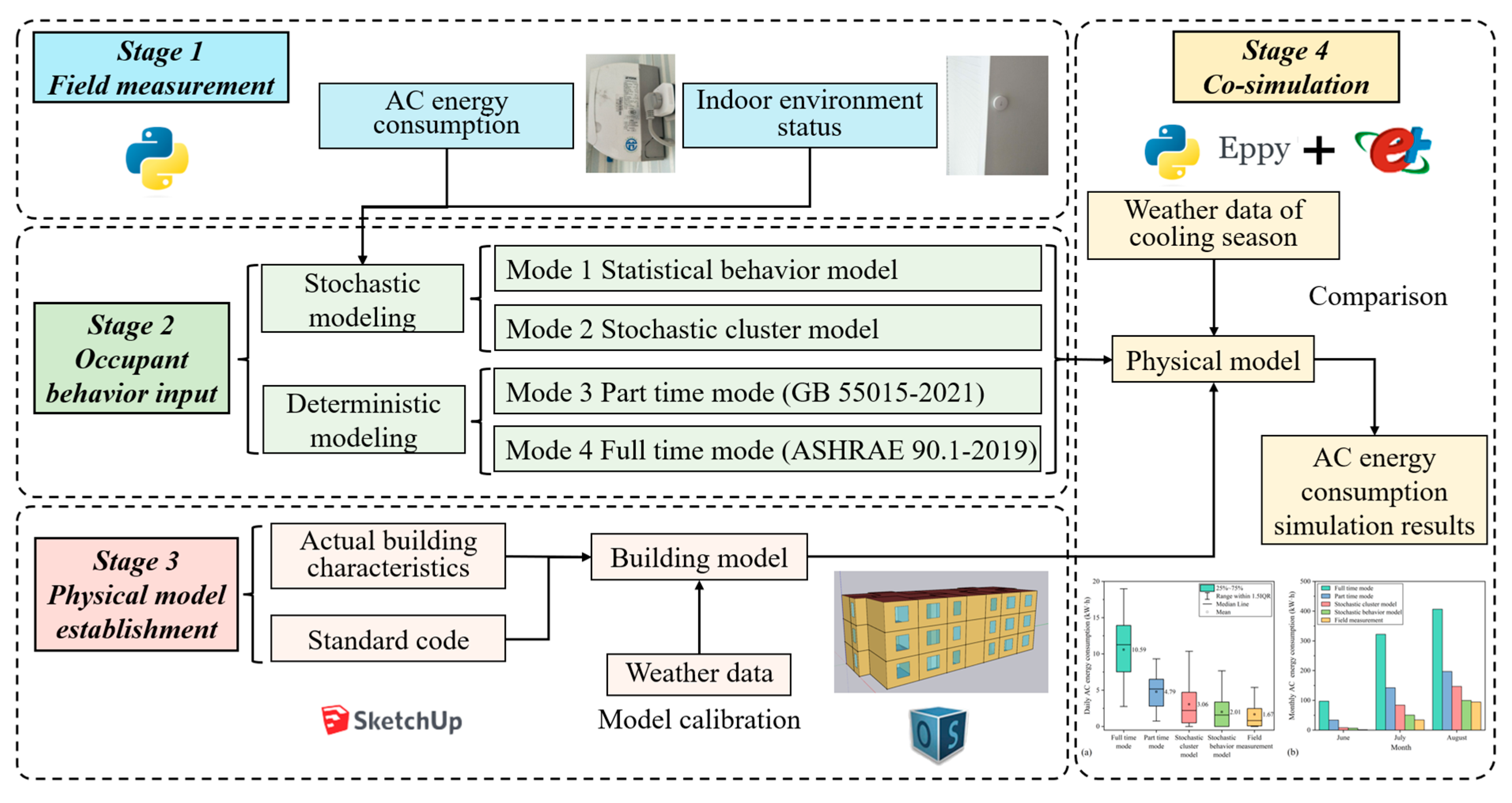


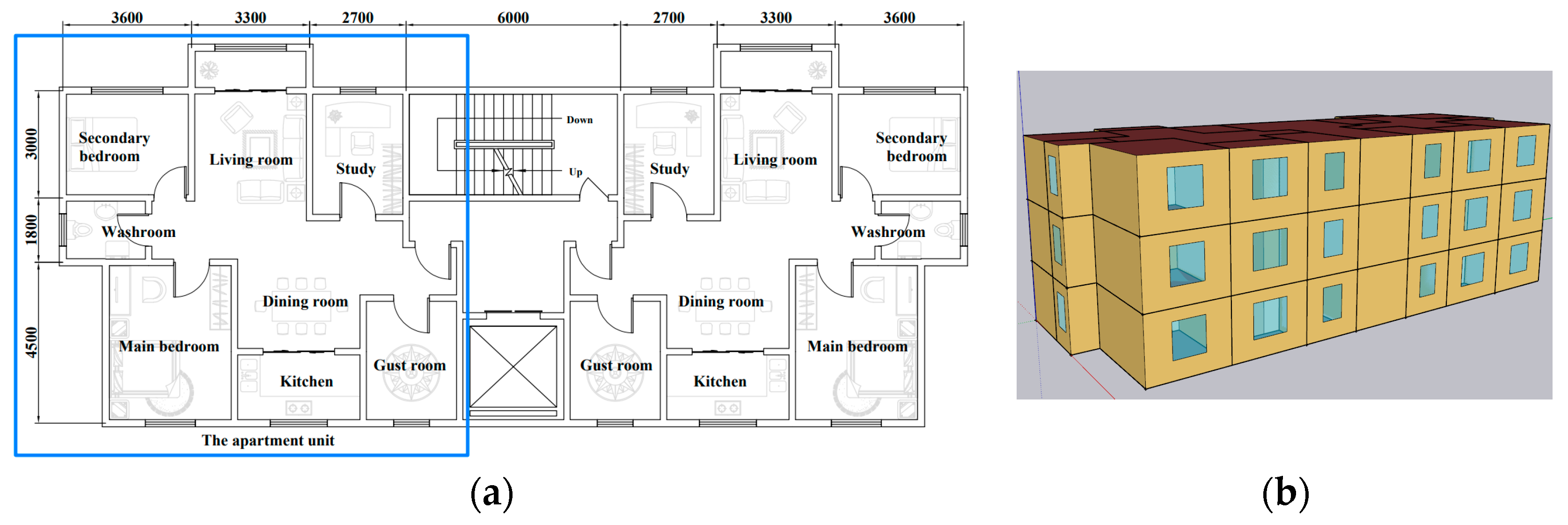

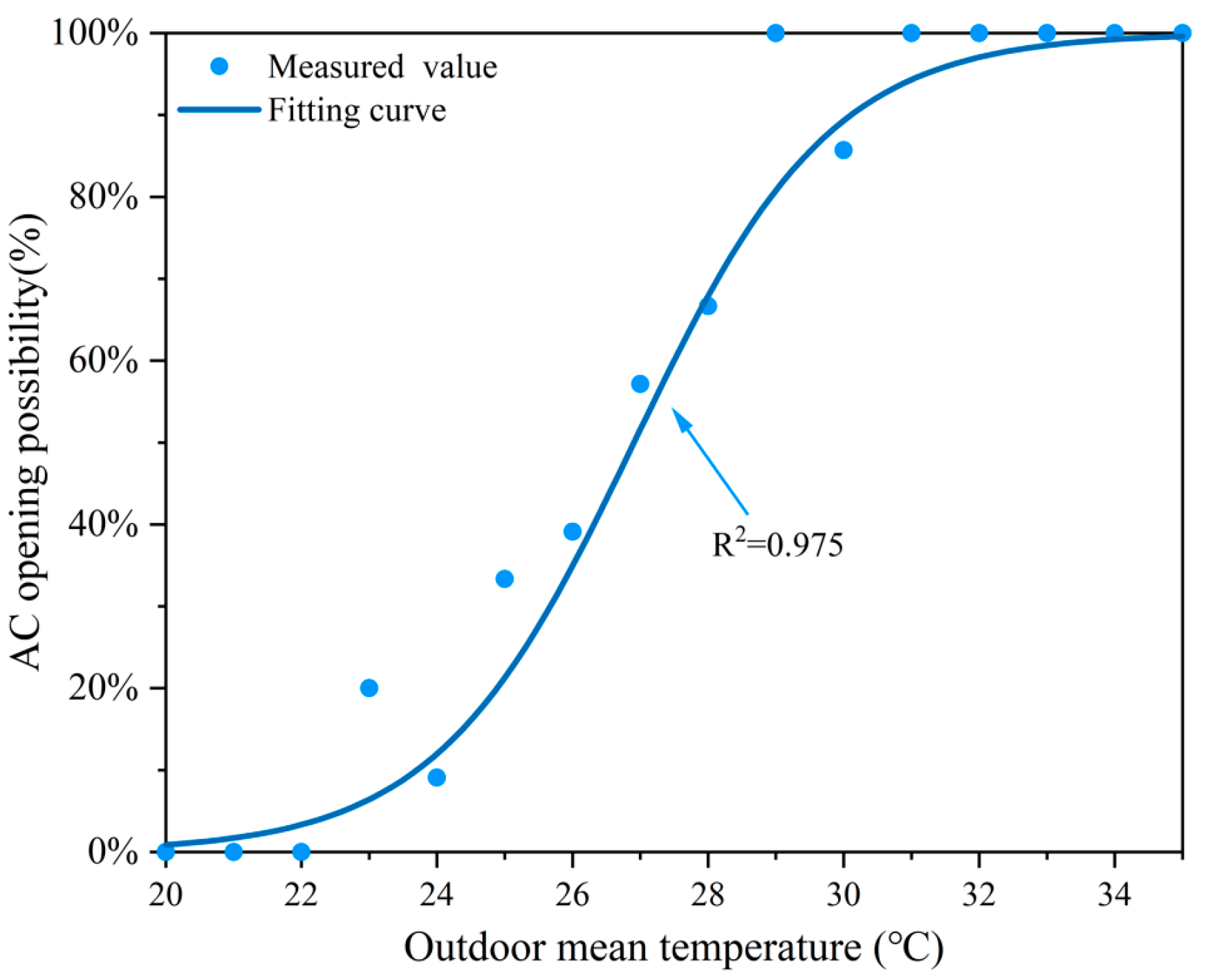
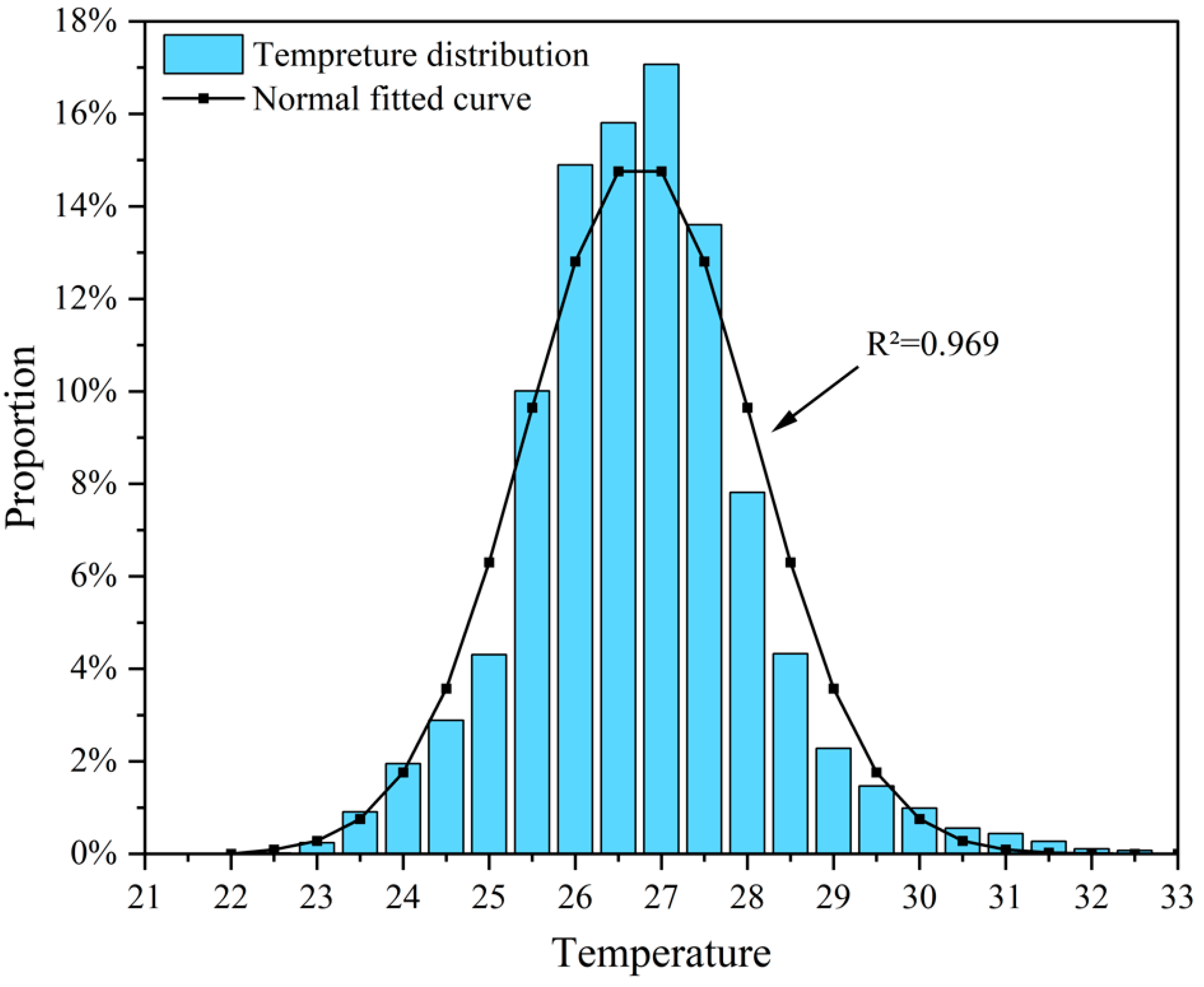
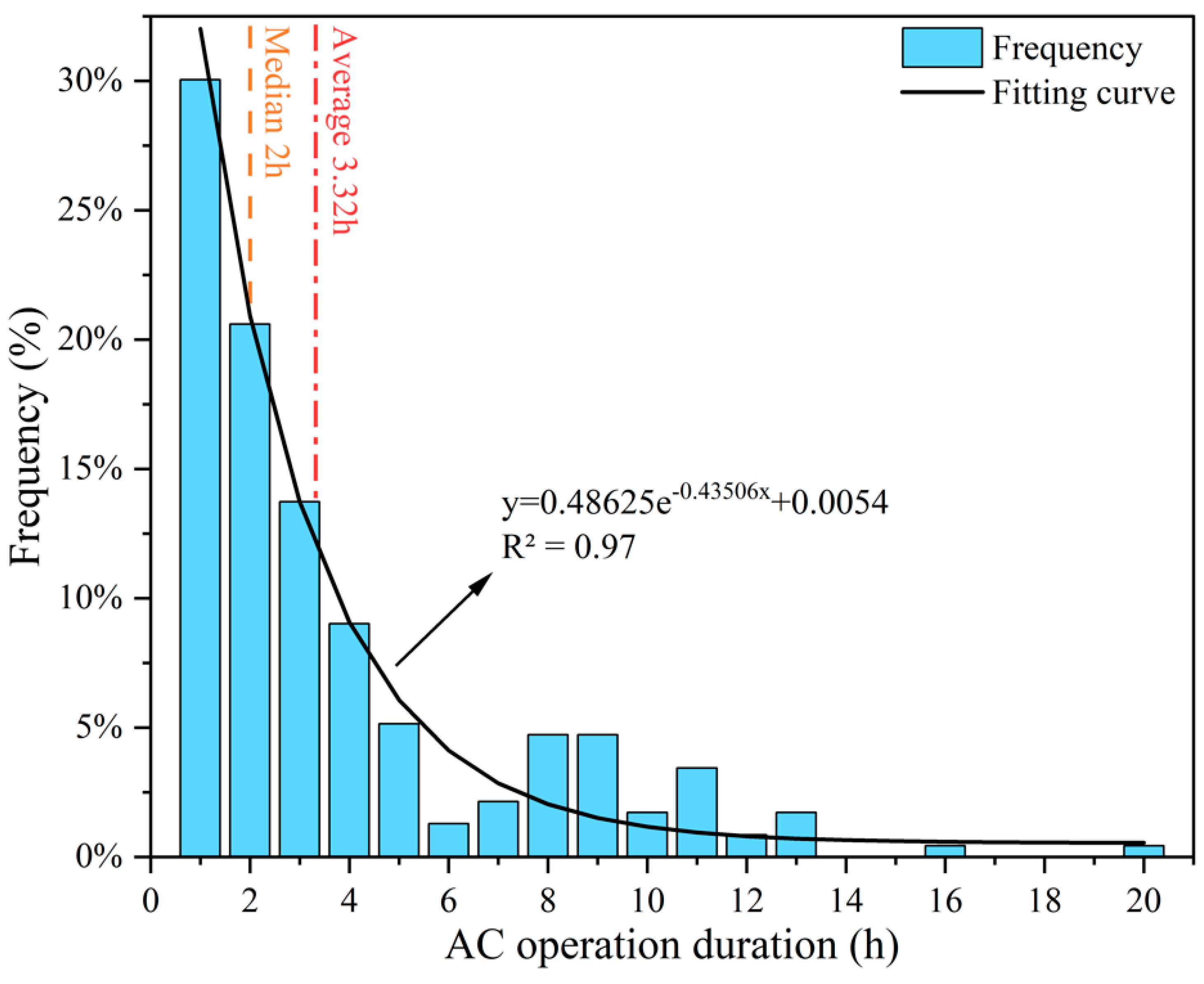
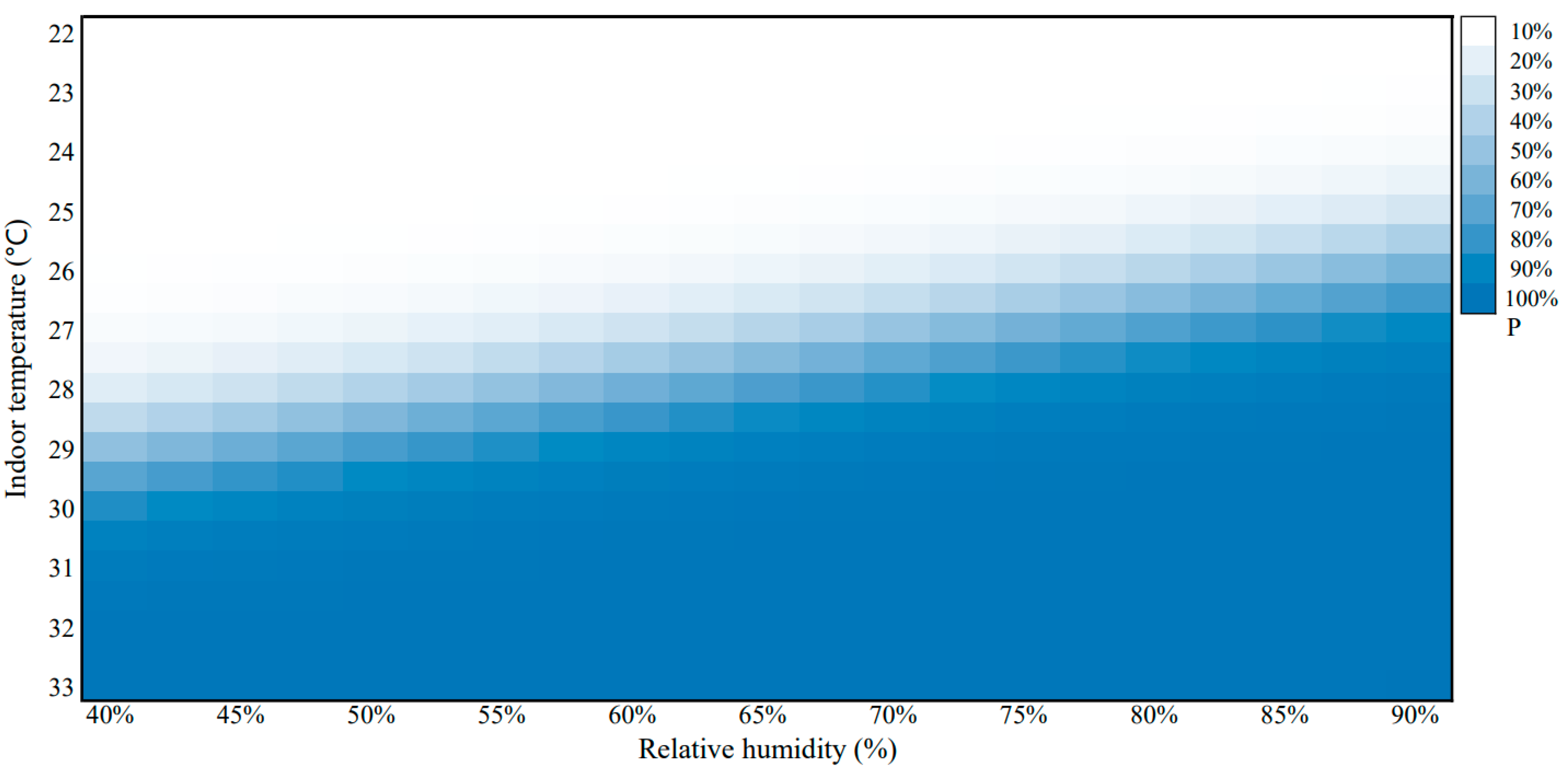

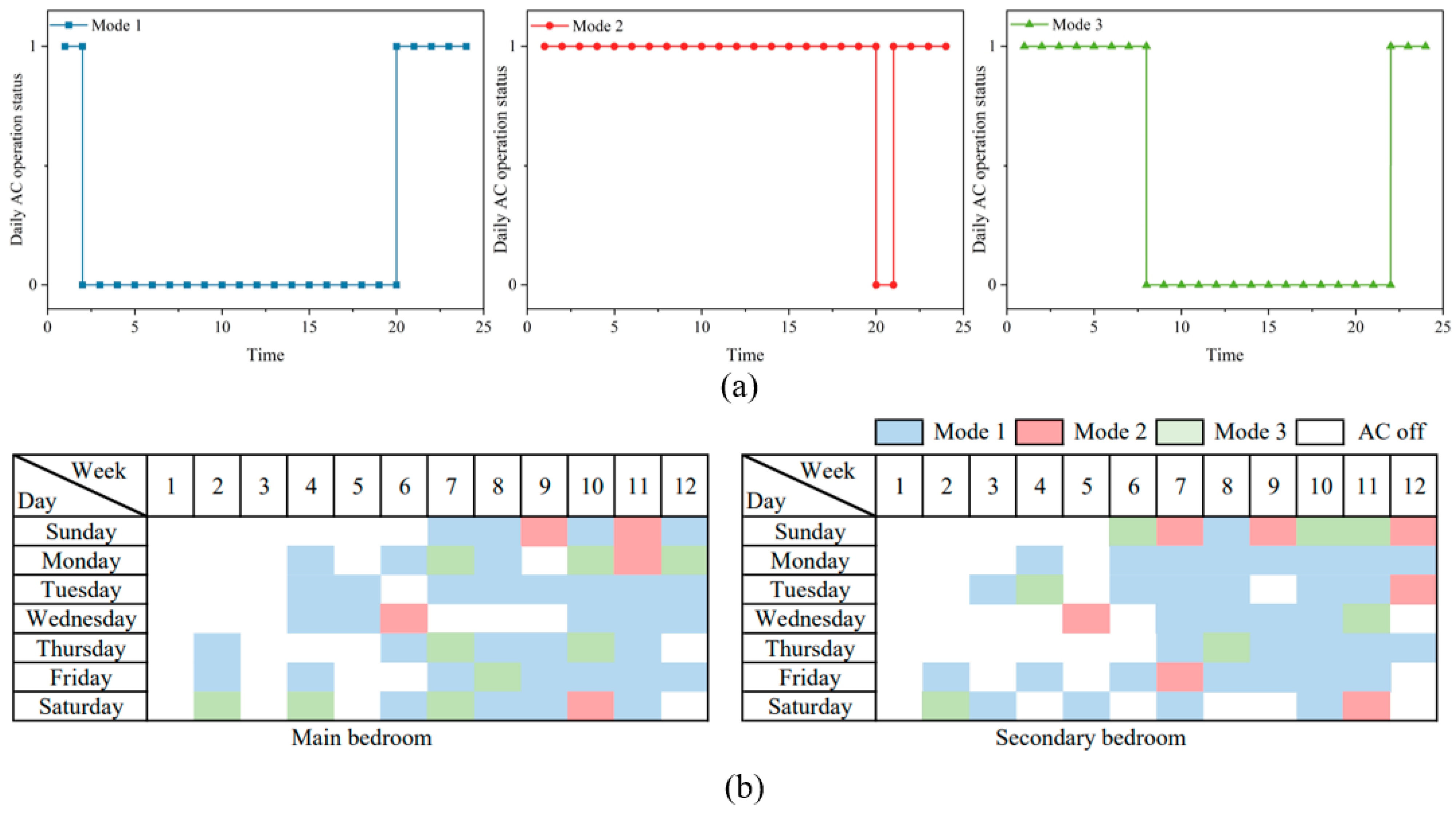
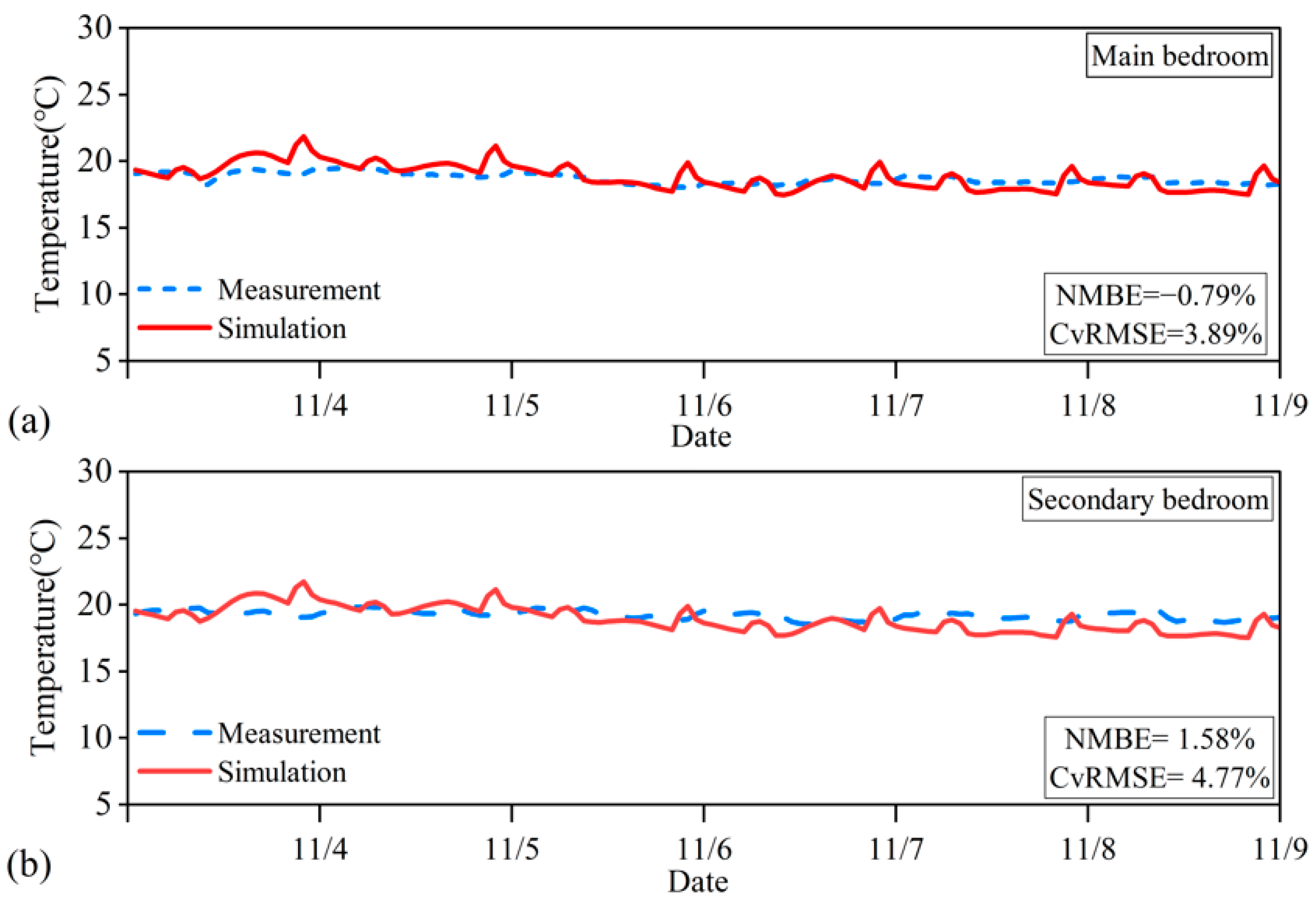


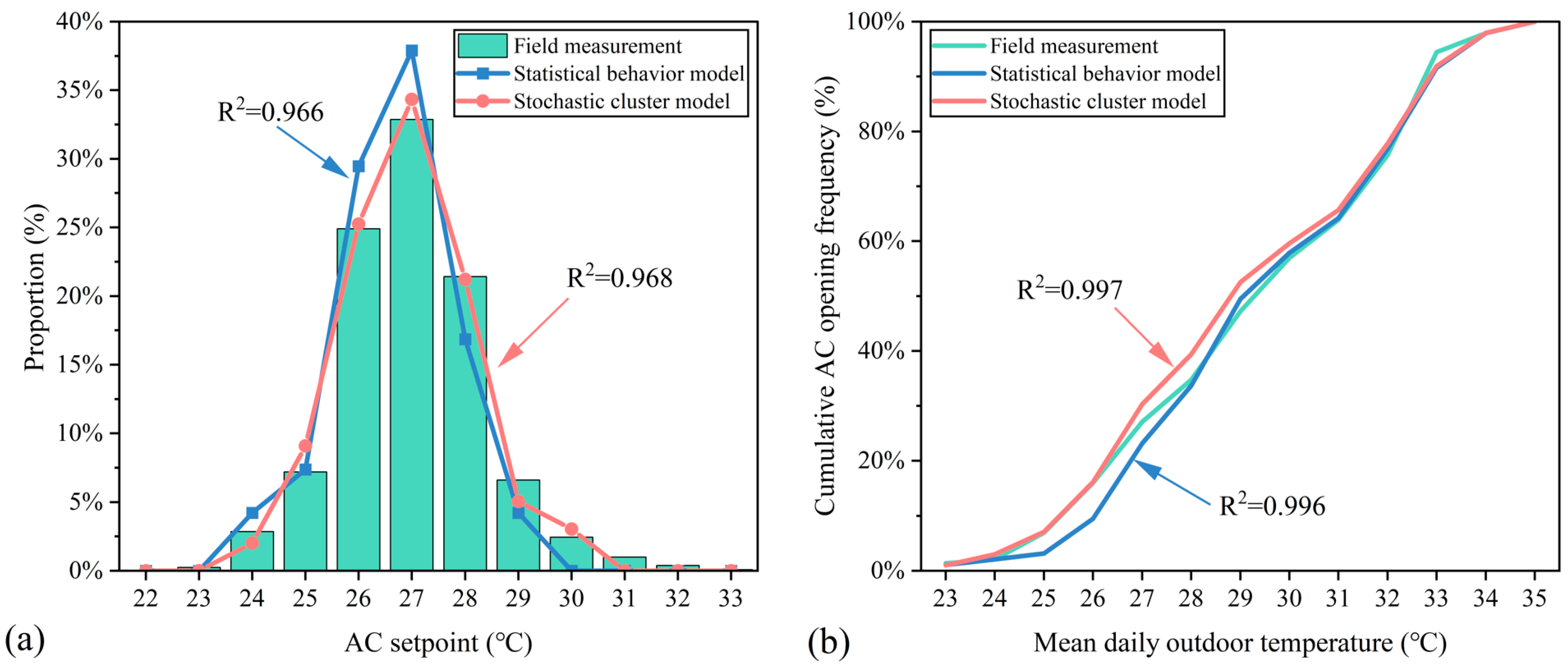


| Instrument | Temperature and Humidity Recorder | Power Recorder |
|---|---|---|
| Model | WSDCGQ01LM | KTBL11LM |
| Working range | −20~+60 °C, 0~100%RH | −10~+40 °C, 0~95%RH |
| Accuracy | ±0.3 °C, ±3% RH | ±0.01 W |
| Test interval | 1 min | 1 min |
| Category | Operation Mode | Bedroom AC Usage Setting | Reference | |
|---|---|---|---|---|
| Setpoint | Schedule | |||
| Residential building bedroom | Part-time mode | 26 °C | 21:00–07:00 | [44] |
| High-rise apartment | Full-time mode | 24.4 °C | 00:00–24:00 | [45] |
| Boundary Conditions | Heat Transfer Coefficient of Exterior Envelope (W/m2·K) | Infiltration Rate (h−1) | |||
|---|---|---|---|---|---|
| Wall | Roof | Floor | Window | ||
| Variables | 0.17 | 0.19 | 0.19 | 2.75 | 1 |
| Room | Lighting Gain | Occupancy Gain | Equipment Gain | |||
|---|---|---|---|---|---|---|
| (W/m2) | Schedule | (m2/person) | Schedule | (W/m2) | Schedule | |
| Bedroom | 5 | 06:00–07:00 and 21:00–22:00 | 25 | 21:00–08:00 | 3.8 | 07:00–08:00 and 21:00–22:00 |
| Living room | 5 | 06:00–07:00 and 19:00–21:00 | 25 | 07:00–21:00 | 3.8 | 07:00–21:00 |
Disclaimer/Publisher’s Note: The statements, opinions and data contained in all publications are solely those of the individual author(s) and contributor(s) and not of MDPI and/or the editor(s). MDPI and/or the editor(s) disclaim responsibility for any injury to people or property resulting from any ideas, methods, instructions or products referred to in the content. |
© 2024 by the authors. Licensee MDPI, Basel, Switzerland. This article is an open access article distributed under the terms and conditions of the Creative Commons Attribution (CC BY) license (https://creativecommons.org/licenses/by/4.0/).
Share and Cite
Ao, J.; Du, C.; Jing, M.; Li, B.; Chen, Z. A Method of Integrating Air Conditioning Usage Models to Building Simulations for Predicting Residential Cooling Energy Consumption. Buildings 2024, 14, 2026. https://doi.org/10.3390/buildings14072026
Ao J, Du C, Jing M, Li B, Chen Z. A Method of Integrating Air Conditioning Usage Models to Building Simulations for Predicting Residential Cooling Energy Consumption. Buildings. 2024; 14(7):2026. https://doi.org/10.3390/buildings14072026
Chicago/Turabian StyleAo, Jingyun, Chenqiu Du, Mingyi Jing, Baizhan Li, and Zhaoyang Chen. 2024. "A Method of Integrating Air Conditioning Usage Models to Building Simulations for Predicting Residential Cooling Energy Consumption" Buildings 14, no. 7: 2026. https://doi.org/10.3390/buildings14072026
APA StyleAo, J., Du, C., Jing, M., Li, B., & Chen, Z. (2024). A Method of Integrating Air Conditioning Usage Models to Building Simulations for Predicting Residential Cooling Energy Consumption. Buildings, 14(7), 2026. https://doi.org/10.3390/buildings14072026






